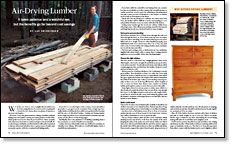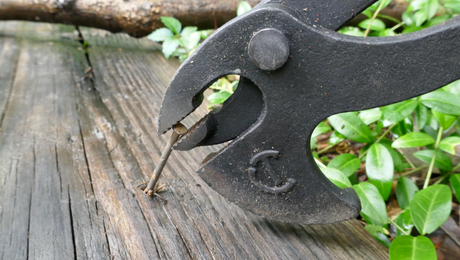Air-Drying Lumber
It takes patience and a watchful eye, but the benefits go far beyond cost savings
Synopsis: Lee Grindinger explains the benefits of drying your own lumber without a kiln, then tells you how to proceed. He describes the shrinkage you can expect, what to tell the mill operator, how to end-coat the log, choose stickers, build a solid stack, how to watch it, and when to stop. An equilibrium moisture chart helps cut down on the guesswork.
Whether you want to save a neighborhood walnut tree from becoming firewood or you’re tired of paying $6 a board foot for cherry, there are plenty of reasons to dry your own lumber.
Of course, cost is the great motivator. Hiring a bandsaw mill and drying your own lumber can buy you many projects’ worth of furniture-grade wood at less than $1 per board foot. These portable saws mean you don’t have to truck your logs to a local sawmill. Also, the cheaper sawblades used by bandsaw mills make it practical to harvest urban and suburban trees, a great source of native and non-native species with the occasional nail lurking inside.
If you live in a wooded region of the country, a local sawmill is a good place to get green stock, sometimes from a single log. Generally, lumber sold directly from mills is not graded and is less than half the price of kiln-dried lumber. Getting and drying lumber from a single log allows you to match boards for furniture and cabinetry.
And finally, there’s the satisfaction of building something from a tree you knew or a stack of lumber you seasoned.
Lumber has been dried without the use of kilns for centuries, in virtually every climate. All it takes is a well-built lumber stack, a watchful eye and patience.
If you have called in a sawmill or are buying from one, remember that wood shrinks as it dries. Instruct the sawmill operator to cut the wood 1 ⁄8 in. over for each 1 in. of thickness. Be aware that it can take a year per inch of thickness to dry lumber, so thicker stock is truly an investment in the future.
Check also that the thickness is uniform. If it varies more than 1 ⁄8 in., the lumber will be difficult to stack, and warping is a very real problem if lumber is not in contact with all of the stickers.
During warm weather get the wood onto stickers within hours of having it sawn. This will prevent staining caused by the bacteria and fungi that invade wet, stacked boards in warm weather.
From Fine Woodworking #151
For the full article, download the PDF below:
Fine Woodworking Recommended Products

Ridgid R4331 Planer

DeWalt 735X Planer

AnchorSeal Log and Lumber End-Grain Sealer





















Log in or create an account to post a comment.
Sign up Log in